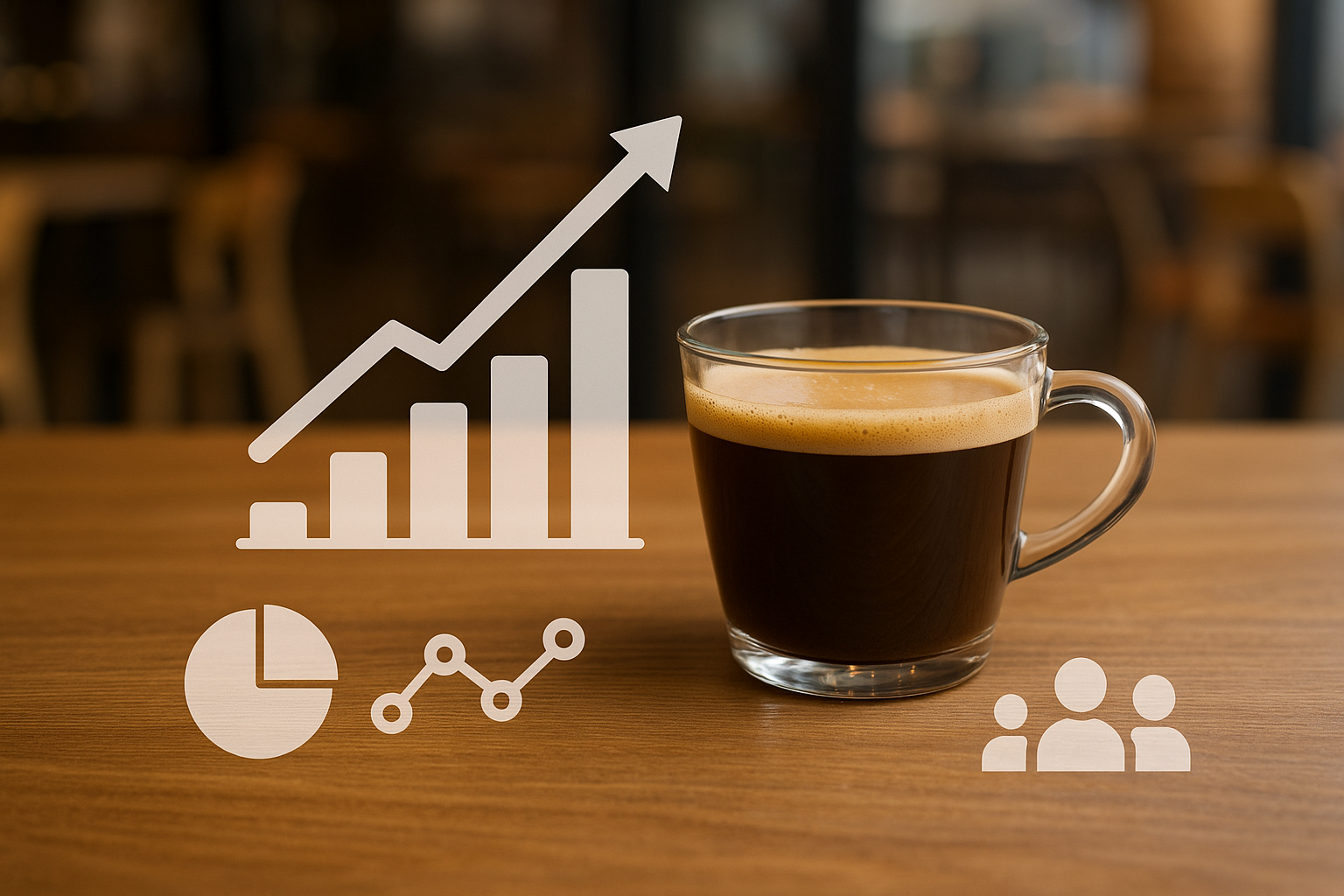In today’s highly competitive coffee market, the difference between a one-time visit and a loyal customer often lies in the details. Flavor, ambiance, service — all are vital. But behind these touchpoints lies something equally powerful: data.
Data analytics is reshaping the specialty café landscape, enabling business owners to understand their customers deeply, anticipate needs, and optimize every part of the coffee experience.
From personalized recommendations to predictive supply management, data is the secret ingredient fueling smarter decisions and stronger customer connections.
In this comprehensive guide, we explore how coffee businesses are collecting and using data to deliver a more personal, efficient, and memorable customer experience — and why this trend is only just beginning.
What Is Coffee Data?
Coffee data refers to any information collected through café operations, customer behavior, sales, equipment performance, and digital engagement. This includes:
- Sales trends by time of day
- Preferred drink combinations
- Frequency of visits
- Ingredients usage and spoilage
- Customer feedback and ratings
- Wi-Fi usage and mobile app interactions
When this data is tracked and analyzed properly, it becomes actionable insight.
It’s not just about numbers. It’s about turning behaviors and patterns into experiences that customers value — and return for.
How Specialty Cafés Collect Data
Unlike big coffee chains with advanced POS systems and loyalty apps, small to mid-sized specialty cafés often think they lack the tools to use data effectively.
But the truth is, even small cafés can gather and analyze meaningful data with the right approach. Here’s how:
Point of Sale (POS) Systems
Modern POS systems track every sale, item combination, and timestamp. They can break down what’s selling well, what’s lagging, and when peak hours occur.
With the right POS, you can segment customer data and monitor which products drive the most loyalty.
Loyalty Programs and Membership Apps
Digital loyalty programs — whether through apps or email marketing — provide insights into individual customer preferences and behaviors.
By tracking redemptions and visits, cafés can learn what keeps people coming back and tailor promotions accordingly.
Feedback and Surveys
Post-purchase surveys or quick tablet-based feedback tools offer direct insight into satisfaction levels. These responses, when quantified, can indicate whether changes in service or recipe improve the overall experience.
Wi-Fi and App Analytics
Free in-store Wi-Fi or branded café apps can track visit duration, device usage, and customer flow. Some cafés use this data to optimize seating layouts or plan better staff coverage during long stays.
Inventory and Equipment Sensors
Connected devices monitor water use, coffee bean output, grinder calibration, and espresso shot consistency. This data ensures quality control and predicts when ingredients will need restocking — which directly impacts service reliability.
Enhancing Customer Experience with Data
Once data is collected, the magic happens in how it’s applied. Below are the most effective ways cafés are using analytics to improve customer experience.
Personalization at Scale
With purchase histories and preferences stored through loyalty programs or apps, cafés can personalize recommendations.
If a customer frequently orders oat milk flat whites and buys a pastry on Wednesdays, the system can suggest a new oat milk drink or offer a promo mid-week.
This kind of personalized attention makes a customer feel recognized — even in a bustling café.
Menu Optimization
By analyzing what items are ordered together, which drinks are returned or rated poorly, and seasonal trends, cafés can tweak their menus with precision.
Removing underperforming items saves costs. Introducing combos based on ordering patterns boosts average ticket size and customer convenience.
Staff Scheduling and Customer Flow
Using historical data, cafés can predict peak times down to the minute. This allows managers to schedule shifts more efficiently, avoiding understaffing during rushes and overstaffing during lulls.
Some businesses even use heatmaps from Wi-Fi data to track movement patterns and redesign store layouts for better service flow.
Inventory Efficiency and Waste Reduction
Data shows which ingredients are used most often, and when. This enables smarter ordering, fresher stock, and less waste — all while ensuring your best-selling drinks are always available.
Some advanced cafés use predictive models that forecast how much milk, beans, or cups will be needed per day, adjusting automatically based on weather, holidays, or past trends.
Predictive Maintenance
IoT-enabled espresso machines and grinders track usage and wear. When integrated with data analytics, they predict when cleaning or parts replacement is needed — preventing breakdowns during peak service.
This minimizes service disruption and extends equipment life, creating a more consistent customer experience.
Marketing That Resonates
With email open rates, order histories, and seasonal behavior, marketing messages can be deeply targeted.
Instead of generic newsletters, customers receive personalized emails based on past visits, drink choices, or birthdays — increasing click-through rates and in-store engagement.
Real-World Example: A Data-Driven Café in Action
Let’s say a café in São Paulo notices that iced coffee orders spike when the temperature exceeds 28°C. By integrating weather data with POS sales records, they start offering iced coffee promos on hot days.
Simultaneously, their loyalty app notes that customers ordering during lunchtime also like vegan pastries. They launch a combo deal, promoting it via push notifications.
After three months, sales grow by 18%, customer satisfaction rises, and inventory waste drops by 12%. All thanks to strategic use of data.
Overcoming Challenges in Data Implementation
While the benefits are huge, data analytics also comes with hurdles:
Data Privacy
Collecting data means handling customer information responsibly. Complying with GDPR or Brazil’s LGPD laws is essential. Customers should know what data is collected, how it’s used, and have the ability to opt out.
Data Overload
Many cafés start collecting data but don’t know what to do with it. Focus on KPIs that affect service directly — like wait times, return rates, and best-selling products — rather than tracking everything aimlessly.
Integration and Cost
Small businesses may struggle with integrating POS, inventory, CRM, and feedback tools. Choosing platforms that connect seamlessly — or investing in consulting — helps bridge this gap.
The cost of analytics software can be intimidating, but most modern POS systems already include basic analytics features. Start simple and scale as needed.
The Human Element Still Matters
Data is powerful, but it doesn’t replace genuine human connection. The warmth of a smile, the care in latte art, or remembering a regular’s name — these still matter.
The role of data is to support, not replace, the barista’s personal touch. Use it to inform, not dictate, your service style.
Looking to the Future: AI, Automation, and Behavior Forecasting
As data systems mature, specialty cafés will move from reactive to predictive service.
Imagine a barista who, just as you approach the counter, sees a screen with your last three orders, your loyalty status, and a suggestion based on the day’s weather and trending ingredients.
AI could help design custom drinks, automate inventory based on macro coffee trends, and even create personalized music or lighting based on customer profiles.
In the near future, your coffee won’t just be made to order — it will be made just for you.

Artur is a coffee enthusiast and content creator passionate about barista techniques and coffee culture. With a sharp eye for detail and a love for learning, he shares practical tips, brewing guides, and gear insights to help readers elevate their coffee experience — from home brewers to aspiring professionals.
